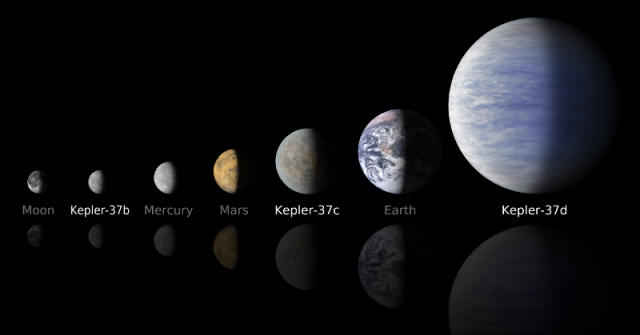
Exoplanets in the Kepler-37 system, compared with Solar System bodies. The smallest of the planets, Kepler-37b, is only slightly larger than the Moon, and noticeably smaller than Mercury.
What's the smallest exoplanet we can detect from Earth? Smaller bodies are inherently harder to observe than larger ones, but the orbiting Kepler telescope has enabled astronomers to identify a number of small planet candidates, including a few smaller than Earth, by measuring the fluctuations in the host star's light as the planets pass in front of it.
Now researchers may have found the smallest exoplanet yet, a world with a diameter about 80 percent of Mercury's. This planet candidate, named Kepler-37b, orbits very close to its star: its orbital radius is about 1/4 the size of Mercury's, so it takes only about 13 days to zip around. Thomas Barclay and collaborators also identified two other planets in the same system—labeled Kepler-37c and Kepler-37d—one of which is slightly larger than Mars, and the other which has twice Earth's diameter. While these worlds are all in very small orbits, their existence contributes to our understanding of the variety of planets that can form.
The Kepler telescope works by collecting light from a huge number of stars in a single patch of the sky. By searching for periodic fluctuations in the light from an individual star, astronomers can find exoplanets as they transit, crossing in front of the disk of the star and blocking a tiny amount of its light. The rapidity of the decrease in light and the fraction of the star's light that is lost to the eclipse reveal the size of the planet, while time between transits indicates the duration of the orbit. Since these effects are small, researchers use sophisticated computer algorithms to pick out exoplanet signals from other fluctuations, such as starspots (sunspots on other stars) .
Because transit observations don't rely on exoplanet mass, they allow astronomers to locate smaller worlds. A small orbit means a slightly larger eclipse, whatever the size of the planet. That's why the Earth-sized exoplanets detected so far are typically much closer to their star than Earth is.
The Kepler-37 system fits this pattern. Its three planets—denoted Kepler-37b, c, and d in order of their distance from the host star—are all much closer to the star than Mercury. The star itself, labeled Kepler-37a, is smaller, cooler, and therefore fainter than the Sun, which also assisted in detecting its planets: less brightness means the exoplanet transits show up more starkly.
Kepler-37d was the easiest to spot, having a diameter approximately twice that of Earth's and an orbit roughly half of Mercury's. (Those factors place the world in the "hot superearth" category, as the planet likely has a rocky surface.) Moving closer to the star, the astronomers measured Kepler-37c's diameter as about 75 percent of Earth's, placing it between Mars and Venus in size. They found its orbit was about 1/3 of Mercury's.
The innermost and smallest planet, Kepler-37b, also had the most ambiguous data. (Frankly, when I looked at their data, I had to take their word for it that there was actually a transit signal hiding in there, but that's what computer algorithms are for.) This world has a diameter only about 30 percent of Earth's, making it measurably smaller than Mercury's 38 percent. Its orbit is blisteringly small—10 percent of Earth's orbit, or 26 percent of Mercury's orbit—and it zips around its star in a mere 13 days.
With its small size and proximity to Kepler-37a, this planet is probably rocky and devoid of surface water or atmosphere. It also may be tidally locked, presenting the same face to its star, just as the same side of the Moon always faces Earth.
The probable discovery of a sub-Mercury-sized exoplanet opens up the possibility of finding more, and giving us a clearer picture of the diversity of planetary bodies. Kepler-37b wasn't a surprise: planet formation models predict the existence of such tiny bodies. However, locating them helps astronomers paint more details into our picture of planetary systems, which are far more varied and wonderful than could be guessed from our Solar System alone.
No comments:
Post a Comment
Let us know your Thoughts and ideas!
Your comment will be deleted if you
Spam , Adv. Or use of bad language!
Try not to! And thank for visiting and for the comment
Keep visiting and spread and share our post !!
Sharing is a kind way of caring!! Thanks again!